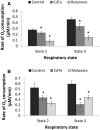Mitochondrial Toxicity of Cadmium Telluride Quantum Dot Nanoparticles in Mammalian Hepatocytes
- PMID: 25809595
- PMCID: PMC4476459
- DOI: 10.1093/toxsci/kfv068
Mitochondrial Toxicity of Cadmium Telluride Quantum Dot Nanoparticles in Mammalian Hepatocytes
Abstract
There are an increasing number of studies indicating that mitochondria are relevant targets in nanomaterial-induced toxicity. However, the underlying mechanisms by which nanoparticles (NPs) interact with these organelles and affect their functions are unknown. The aim of this study was to investigate the effects of cadmium telluride quantum dot (CdTe-QD) NPs on mitochondria in human hepatocellular carcinoma HepG2 cells. CdTe-QD treatment resulted in the enlargement of mitochondria as examined with transmission electron microscopy and confocal microscopy. CdTe-QDs appeared to associate with the isolated mitochondria as detected by their inherent fluorescence. Further analyses revealed that CdTe-QD caused disruption of mitochondrial membrane potential, increased intracellular calcium levels, impaired cellular respiration, and decreased adenosine triphosphate synthesis. The effects of CdTe-QDs on mitochondrial oxidative phosphorylation were evidenced by changes in levels and activities of the enzymes of the electron transport chain. Elevation of peroxisome proliferator-activated receptor-γ coactivator levels after CdTe-QD treatment suggested the effects of CdTe-QDs on mitochondrial biogenesis. Our results also showed that the effects of CdTe-QDs were similar or greater to those of cadmium chloride at equivalent concentrations of cadmium, suggesting that the toxic effects of CdTe-QDs were not solely due to cadmium released from the NPs. Overall, the study demonstrated that CdTe-QDs induced multifarious toxicity by causing changes in mitochondrial morphology and structure, as well as impairing their function and stimulating their biogenesis.
Keywords: cadmium telluride quantum dots; cellular respiration; electron transport chain; hepatocytes; membrane potential; mitochondria.
© The Author 2015. Published by Oxford University Press on behalf of the Society of Toxicology.
Figures









Similar articles
-
Hepatotoxicity of Cadmium Telluride Quantum Dots Induced by Mitochondrial Dysfunction.Chem Res Toxicol. 2020 Sep 21;33(9):2286-2297. doi: 10.1021/acs.chemrestox.9b00526. Epub 2020 Sep 3. Chem Res Toxicol. 2020. PMID: 32844644
-
Cadmium telluride quantum dots cause oxidative stress leading to extrinsic and intrinsic apoptosis in hepatocellular carcinoma HepG2 cells.Toxicology. 2013 Apr 5;306:114-23. doi: 10.1016/j.tox.2013.02.010. Epub 2013 Feb 26. Toxicology. 2013. PMID: 23485651
-
Long-term exposure to CdTe quantum dots causes functional impairments in live cells.Langmuir. 2007 Feb 13;23(4):1974-80. doi: 10.1021/la060093j. Epub 2007 Jan 12. Langmuir. 2007. PMID: 17279683
-
Aqueous phase synthesis of CdTe quantum dots for biophotonics.J Biophotonics. 2011 Jan;4(1-2):9-20. doi: 10.1002/jbio.201000080. Epub 2010 Sep 28. J Biophotonics. 2011. PMID: 20878905 Review.
-
Perspectives on the toxicology of cadmium-based quantum dots.Curr Drug Metab. 2013 Oct;14(8):847-56. doi: 10.2174/138920021131400106. Curr Drug Metab. 2013. PMID: 24016111 Review.
Cited by
-
Reproductive toxicity and gender differences induced by cadmium telluride quantum dots in an invertebrate model organism.Sci Rep. 2016 Sep 27;6:34182. doi: 10.1038/srep34182. Sci Rep. 2016. PMID: 27669995 Free PMC article.
-
A Review of in vivo Toxicity of Quantum Dots in Animal Models.Int J Nanomedicine. 2023 Dec 29;18:8143-8168. doi: 10.2147/IJN.S434842. eCollection 2023. Int J Nanomedicine. 2023. PMID: 38170122 Free PMC article. Review.
-
Novel Pyrroloquinoline Quinone-Modified Cerium Oxide Nanoparticles and Their Selective Cytotoxicity Under X-Ray Irradiation.Antioxidants (Basel). 2024 Nov 24;13(12):1445. doi: 10.3390/antiox13121445. Antioxidants (Basel). 2024. PMID: 39765774 Free PMC article.
-
Antioxidant Activity of Oat Proteins Derived Peptides in Stressed Hepatic HepG2 Cells.Antioxidants (Basel). 2016 Oct 20;5(4):39. doi: 10.3390/antiox5040039. Antioxidants (Basel). 2016. PMID: 27775607 Free PMC article.
-
Dependence of Nanoparticle Toxicity on Their Physical and Chemical Properties.Nanoscale Res Lett. 2018 Feb 7;13(1):44. doi: 10.1186/s11671-018-2457-x. Nanoscale Res Lett. 2018. PMID: 29417375 Free PMC article. Review.
References
-
- Adiele R. C., Stevens D., Kamunde C. (2012). Differential inhibition of electron transport chain enzyme complexes by cadmium and calcium in isolated rainbow trout (Oncorhynchus mykiss) hepatic mitochondria. Toxicol. Sci. 127, 110–119. - PubMed
-
- Armstrong J. S. (2006). Mitochondrial membrane permeabilization: The sine qua non for cell death. Bioessays 28, 253–260. - PubMed
-
- Baratli Y., Charles A. L., Wolff V., Ben Tahar L., Smiri L., Bouitbir J., Zoll J., Piquard F., Tebourbi O., Sakly M., et al. (2013). Impact of iron oxide nanoparticles on brain, heart, lung, liver, and kidneys mitochondrial respiratory chain complexes activities and coupling. Toxicol. in vitro 27, 2142–2148. - PubMed
Publication types
MeSH terms
Substances
LinkOut - more resources
Full Text Sources
Other Literature Sources

